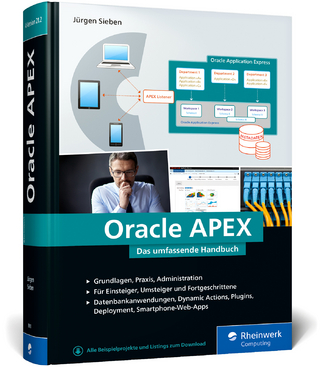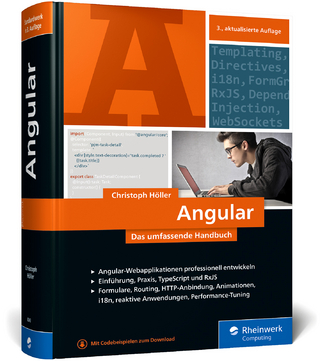
Android Database Best Practices
Addison-Wesley Educational Publishers Inc (Verlag)
978-0-13-443799-6 (ISBN)
- Titel ist leider vergriffen;
keine Neuauflage - Artikel merken
“Android™ Database Best Practices goes well beyond API documentation to offer strategic advice about how to handle data in an Android application and the tools needed to develop productively. This arms the developer with a trove of solutions to nearly any problem an application may face involving data. Mastering the concepts in this book are therefore essential for any developer who wants to create professional Android applications.”
–Greg Milette, Android developer, Gradison Technologies, Inc.
This is the first guide to focus on one of the most critical aspects of Android development: how to efficiently store, retrieve, manage, and share information from your app’s internal database. Through real-world code examples, which you can use in your own apps, you’ll learn how to take full advantage of SQLite and the database-related classes on Android.
A part of Addison-Wesley’s Android™ Deep Dive series for experienced Android developers, Android Database Best Practices draws on Adam Stroud’s extensive experience leading cutting-edge app projects.
Stroud reviews the core database theory and SQL techniques you need to efficiently build, manipulate, and read SQLite databases. He explores SQLite in detail, illuminates Android’s APIs for database interaction, and shares modern best practices for working with databases in the Android environment.
Through a complete case study, you’ll learn how to design your data access layer to simplify all facets of data management and avoid unwanted technical debt. You’ll also find detailed solutions for common challenges in building data-enabled Android apps, including issues associated with threading, remote data access, and showing data to users. Extensive, up-to-date sample code is available for download at github.com/android-database-best-practices/device-database.
You will
Discover how SQLite database differs from other relational databases
Use SQL DDL to add structure to a database, and use DML to manipulate data
Define and work with SQLite data types
Persist highly structured data for fast, efficient access
Master Android classes for create, read, update, and delete (CRUD) operations and database queries
Share data within or between apps via content providers
Master efficient UI strategies for displaying data, while accounting for threading issues
Use Android’s Intents API to pass data between activities when starting a new activity or service
Achieve two-way communication between apps and remote web APIs
Manage the complexities of app-to-server communication, and avoid common problems
Use Android’s new Data Binding API to write less code and improve performance
Adam Stroud is an Android developer who has been developing apps for Android since 2010. He has been an early employee at multiple startups including RunKeeper, Mustbin, and Chef Nightly, and has led the Android development from the ground up. He has a strong passion for Android and open source and seems to be attracted to all things Android. In addition to writing code, has also written other books on Android development and enjoys giving talks on a wide range of Android topics including Android development and gaining root access on Android devices. He loves being a part of the Android community and getting together with other Android enthusiasts to “geek out”. Adam is currently the technical co-founder and lead Android architect at a new startup where he oversees the development of the Android app.
Preface xv
Acknowledgments xix
About the Author xxi
Chapter 1: Relational Databases 1
History of Databases 1
The Relational Model 3
Relational Languages 9
Database Languages 14
Summary 15
Chapter 2: An Introduction to SQL 17
Data Definition Language 17
Data Manipulation Language 28
Queries 32
Summary 37
Chapter 3: An Introduction to SQLite 39
SQLite Characteristics 39
SQLite Features 39
What SQLite Does Not Support 42
SQLite Data Types 43
Summary 44
Chapter 4: SQLite in Android 47
Data Persistence in Phones 47
Android Database API 47
Strategies for Upgrading Databases 58
Database Access and the Main Thread 60
Exploring Databases in Android 61
Summary 77
Chapter 5: Working with Databases in Android 79
Manipulating Data in Android 79
Transactions 87
Running Queries 89
Cursors 91
CursorLoader 94
Summary 99
Chapter 6: Content Providers 101
REST-Like APIs in Android 101
Content URIs 102
Exposing Data with a Content Provider 102
Exposing a Remote Content Provider to External Apps 108
Content Provider Contract 112
Allowing Access from an External App 114
Implementing a Content Provider 115
When Should a Content Provider Be Used? 132
Summary 135
Chapter 7: Databases and the UI 137
Getting Data from the Database to the UI 137
Cursors as Observers 143
Accessing a Content Provider from an Activity 145
Summary 161
Chapter 8: Sharing Data with Intents 163
Sending Intents 163
Receiving Implicit Intents 166
Building an Intent 167
ShareActionProvider 173
Summary 175
Chapter 9: Communicating with Web APIs 177
REST and Web Services 177
Accessing Remote Web APIs 179
Persisting Data to Enhance User Experience 206
Android SyncAdapter Framework 207
Manually Synchronizing Remote Data 218
Summary 229
Chapter 10: Data Binding 231
Adding Data Binding to an Android Project 231
Data Binding Layouts 232
Using Data Binding to Replace Boilerplate Code 242
Data Binding Expression Language 246
Summary 247
Index 249
| Erscheinungsdatum | 17.10.2016 |
|---|---|
| Verlagsort | New Jersey |
| Sprache | englisch |
| Maße | 179 x 229 mm |
| Gewicht | 468 g |
| Themenwelt | Mathematik / Informatik ► Informatik ► Datenbanken |
| Informatik ► Software Entwicklung ► Mobile- / App-Entwicklung | |
| Informatik ► Weitere Themen ► Smartphones / Tablets | |
| ISBN-10 | 0-13-443799-3 / 0134437993 |
| ISBN-13 | 978-0-13-443799-6 / 9780134437996 |
| Zustand | Neuware |
| Informationen gemäß Produktsicherheitsverordnung (GPSR) | |
| Haben Sie eine Frage zum Produkt? |
aus dem Bereich


